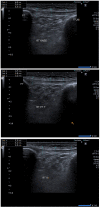Efficacy of ultrasound guided dry needling as an adjunct to conventional physical therapy for patients with jumper's knee: A randomized controlled trial
- PMID: 36406368
- PMCID: PMC9672502
- DOI: 10.3389/fsurg.2022.1023902
Efficacy of ultrasound guided dry needling as an adjunct to conventional physical therapy for patients with jumper's knee: A randomized controlled trial
Abstract
Background: Jumper's knee is a degenerative condition among athletes, and it has been treated with conventional physical therapy (CPT). Ultrasound guided dry needling (USG-DN) is a relatively new technique to explore clinical outcomes in patients with tendinopathy.
Methods: This parallel group, single-blinded randomized controlled trial was carried out involving 94 athletes with clinically diagnosed jumper's knee, divided into an intervention group (USG-DN + CPT, n = 47) and a control group (CPT, n = 47). Participants received a 4-week programme; the intervention group received ultrasound guided patellar tendon dry needling (DN) in conjunction with CPT. The control group received only CPT. The visual analog scale (VAS), Victorian institute of sports assessment-Patellar tendinopathy (VISA-P) questionnaire, Lysholm scale, Knee injury and osteoarthritis outcome score (KOOS) and ultrasonographic features of patellar tendinopathy were evaluated at baseline,1 week, 2 weeks, and 4 weeks. The data were analyzed through SPSS-26.
Results: The study found statistically significant differences (P < 0.05) regarding VAS, Lysholm, VISA-P, and KOOS scales at baseline, 1st, 2nd, and 4th week post-intervention. Within-group differences also showed statistically significant results after the intervention. There were significant results observed in ultrasonographic outcomes between both groups at 1 month post-intervention (all P < 0.05).
Conclusion: The results of the current study suggest, ultrasound guided DN of patellar tendon in combination with CPT reduced pain, improved function, and showed a tendency to decrease tendon thickness in patients with patellar tendinopathy.
Clinical trial registration number: (IRCT20210409050913N1). Dated: 17.04.2021. https://www.irct.ir/user/trial/55607/view.
Keywords: clinical trial; dry needling; jumper's knee; patellar tendinopathy; ultrasonogaphy.
© 2022 Sharif, Ahmad, Gilani, Bacha, Hanif and Arif.
Conflict of interest statement
The authors declare that the research was conducted in the absence of any commercial or financial relationships that could be construed as a potential conflict of interest.
Figures


References
-
- Vicenzino B, de Vos RJ, Alfredson H, Bahr R, Cook JL, Coombes BK, et al. ICON 2019—International scientific tendinopathy symposium consensus: there are nine core health-related domains for tendinopathy (CORE DOMAINS): Delphi study of healthcare professionals and patients. Br J Sports Med. (2020) 54:444–51. 10.1136/bjsports-2019-100894 - DOI - PubMed
LinkOut - more resources
Full Text Sources
Miscellaneous

